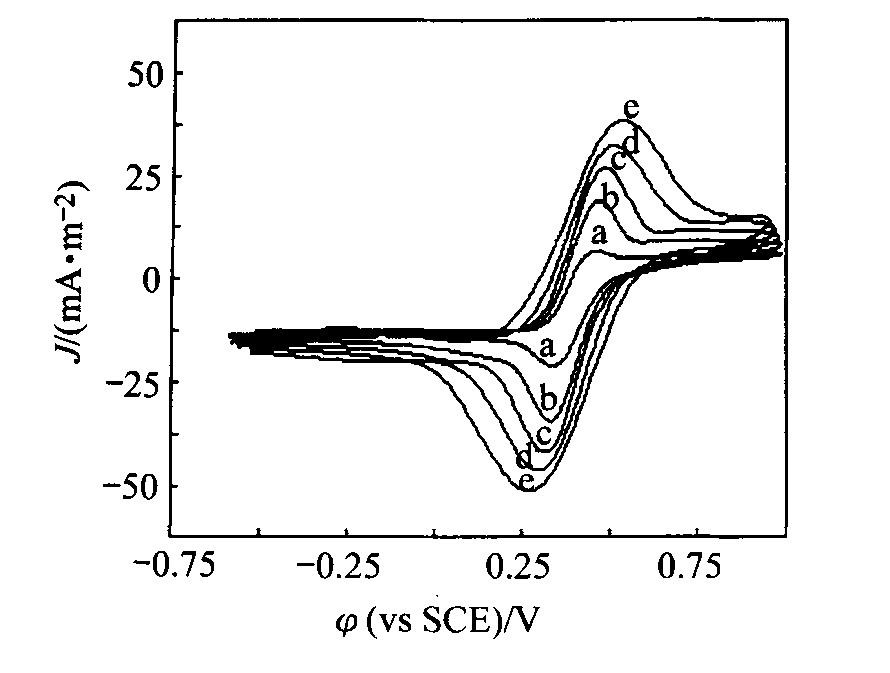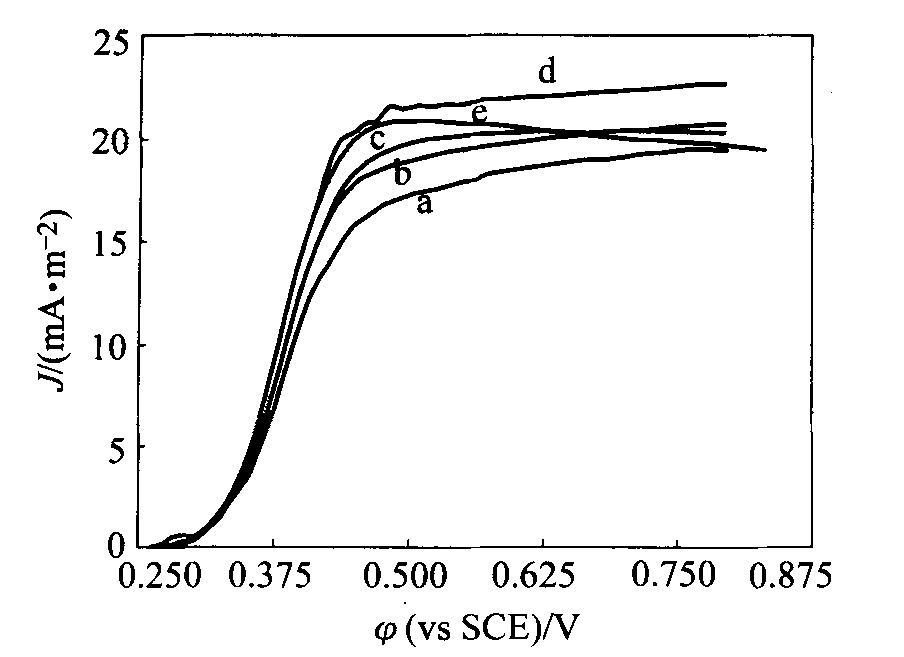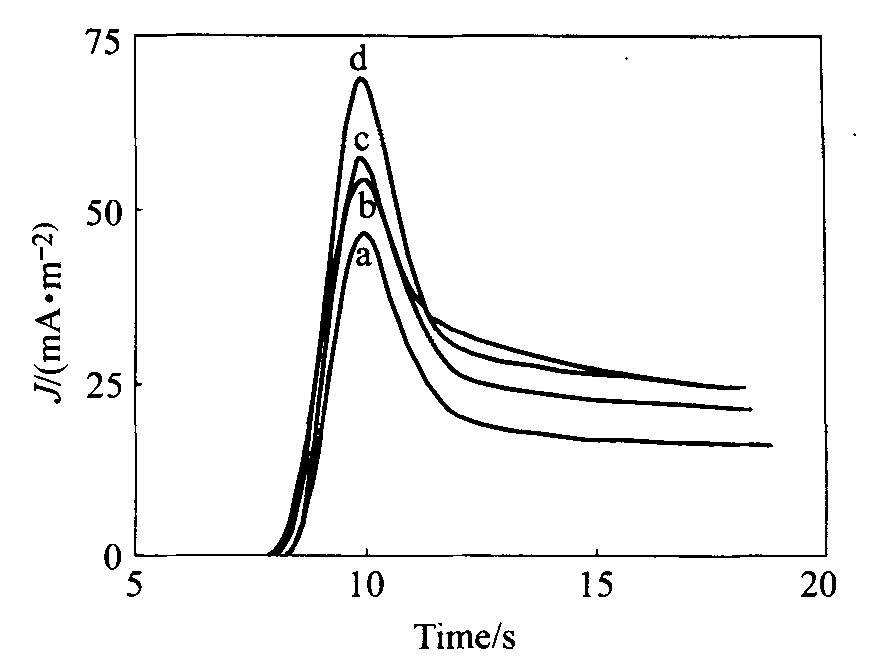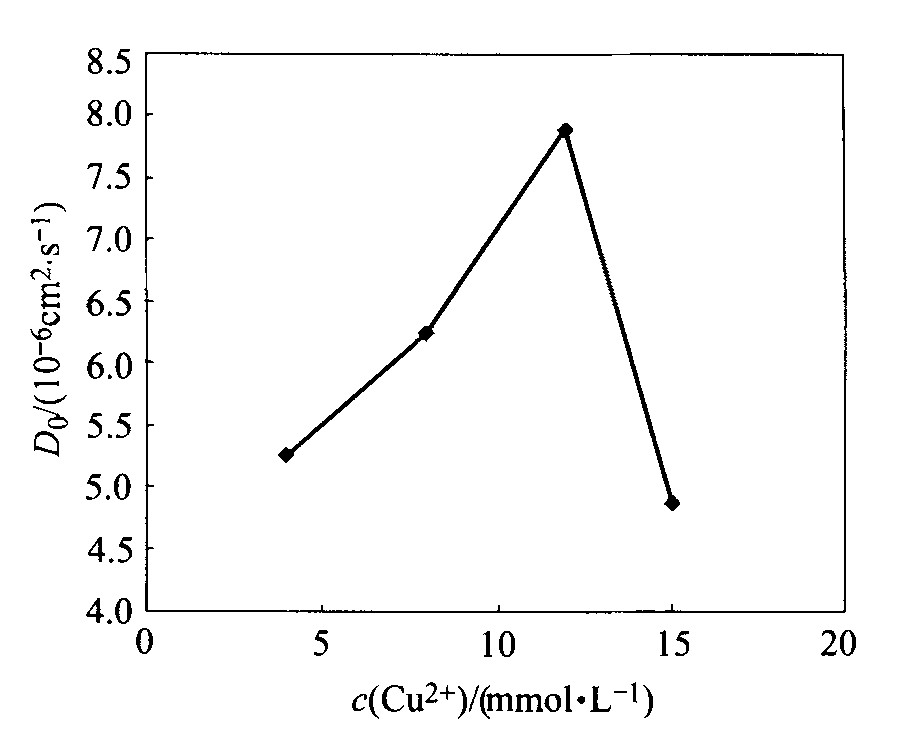中国有色金属学报 2003,(01),229-233 DOI:10.19476/j.ysxb.1004.0609.2003.01.042
Cu2+对Fe2+在T.f菌修饰粉末微电极上氧化行为的影响
北京有色金属研究总院,中南大学矿物工程系,中南大学矿物工程系,北京有色金属研究总院,北京有色金属研究总院 北京100088 ,长沙410083 ,长沙410083 ,北京100088中南大学矿物工程系,长沙410083 ,北京100088
摘 要:
Fe2 + 的氧化在细菌浸矿过程中具有重要作用 ,细菌浸铜过程中 ,Cu2 + 的存在对T .f菌的生长代谢和其氧化Fe2 + 的能力有一定影响。制备了T .f菌修饰碳粉粉末微电极 ,研究了Cu2 + 存在下Fe2 + 在T .f菌修饰粉末微电极上氧化的电化学反应机理 ,并测定了相应的电极过程动力学参数。循环伏安研究表明 ,Cu2 + 的存在不影响Fe2 + 在T .f菌修饰粉末微电极上的氧化反应的可逆性。对电极稳态及暂态过程研究表明 ,当Cu2 + 浓度在 12mmol/L以下时 ,Cu2 + 的存在不会抑制Fe2 + 在T .f菌修饰粉末微电极上的氧化 ,适量Cu2 + 加强T .f菌氧化Fe2 +的作用是在于其加快了电荷传递速率
关键词:
中图分类号: TF18
作者简介:李宏煦(1971),男,高级工程师,博士;
收稿日期:2001-12-24
基金:国家自然科学基金资助项目 (5 0 2 0 40 0 1);
Influence of Cu2+ on oxidation of Fe2+ on thiobacillus ferr oxidans modified powder microelectrode
Abstract:
The oxidation of Fe 2+ plays a v er y important role in bio-leaching, the exist of Cu 2+ has a un-excluded in fluence on the oxidation of Fe 2+ and the growth of thiobacillus ferrooxidans. Using the thiobacillus ferroxidans modified carbon powder microelectrode, the electrochemical mechanism of the i nfluence of Cu 2+ on the oxidation of Fe 2+ was studied. The Cyclic vo ltammetry study shows that the presence of Cu 2+ can not change the reversi bility of Fe 2+ oxidation reaction. Steady potentiodynamic and transient st air-step measurement demonstrate that the presence of Cu 2+ can not suppre ss the oxidation of Fe 2+ on the thiobacillus ferroxidans modified powder microelectrode. However when the concentration of Cu 2+ is under 15 mmol/L , it can enhance the mass transfer coefficient and accele rate the charge transfer rate of oxidation reaction
Keyword:
bio-leaching; thiobacillus ferroxidans modified powder microelectrode; electrochemistry mechanism;
Received: 2001-12-24
T.f菌为生物冶金浸矿过程的主导菌种, T.f菌必须迅速氧化大量的Fe2+以获得能量而维持正常的生理代谢。 在细菌浸矿过程中, 其对Fe2+的氧化具有两方面的作用: 一方面, Fe2+的氧化为T.f菌的生长提供能量以完成其生理代谢, 促进T.f菌的生长繁殖, 增大细菌数量, 为细菌浸矿提供基础
1实验
1.1 T.f菌分离、 纯化及其修饰粉末微电极制备
浸矿主导菌株T.f菌是由广东大宝山酸性矿坑水中分离、 纯化得到, 并根据试验需要驯化。 T.f菌培养基用标准9 K培养基, 其组成为(g/L):(NH4)2SO4 3.0, KCl 0.1, K2HPO4 0.5, MgSO4·7H2O 0.5, Ca(NO3)2 0.01, Fe2+ 9。 以上试剂均为分析纯, 培养基用去离子水配制, 培养基pH根据需要用6 mol/L的H2SO4调节。
制备微铂盘电极时, 用煮沸王水将其腐蚀出一个d 0.1 mm深20~50 μm的微孔。 取光谱纯石墨粉, 加入一定量纯T.f菌液, 拌均匀, 制成细菌表面修饰粉末, T.f菌则通过细胞表面分泌出的蛋白物粘附于碳糊表面, 待一定时间后, 压入铂盘微电极微孔, 压入时将粉末放于平镜上, 反复加压以保证电极表面平整光洁
1.2电化学实验
稳态极化曲线、 循环伏安曲线、 电位阶跃曲线等的测定均采用典型的三电极体系, 以T.f菌修饰粉末微电极为工作电极, 饱和氯化钾甘汞电极为参比电极, 铂片电极为对电极, 参比电极和工作电极之间由带有鲁金毛细管的盐桥连接。 在500 mL的电解槽中, 用英国Solartron公司的S1-1287 电化学测量系统(包括恒电位仪、 信号发生器、 函数记录仪、 PⅢ计算机、 Corrware和Corrview测试软件)进行测试, 电解质为加入了Cu2+并具有Fe2+的9K液。 配制9K培养液及其它用的化学药品均为分析纯, 配制溶液及洗涤均用去离子水。
2结果与讨论
2.1Fe2+在修饰粉末微电极上氧化的特征
不同扫描速度下, Fe2+在T.f菌修饰碳糊微电极的循环伏安测量如图1所示, 由图可知, 随着扫描速度的增加峰电流增大, 阳极峰电流始终与阴极峰电流基本相等, 根据粉末微电极理论及对Fe2+在T.f菌修饰粉末微电极上氧化机理的研究, 可以推断该反应为一可逆反应
图1 Fe2+在T.f菌修饰碳糊微电极上的 循环伏安图
Fig.1 Cycle voltammograms of Fe2+ on T.f modified carbon micro electrode under different scan rates
(pH=2.0; θ=25 ℃; c(FeSO4)=0.16 mol/L; Initial sweep: anode) a—1 mV/s; b—2 mV/s; c—3 mV/s; d—4 mV/s; e—5 mV/s
2. 2Cu2+对Fe2+在T.f菌电极上氧化反应的影响
加入不同浓度的Cu2+离子, FeSO4为0.16 mol/L时, T.f菌修饰碳糊微电极循环伏安曲线如图2所示。 不同Cu2+离子浓度下循环伏安曲线各参数的关系见表1。
结果显示, 不同Cu2+离子浓度时阳极峰电流始终和阴极峰电流相等, 且Δ φp保持不变, 可见Cu2+离子的加入不影响反应的可逆性。 同时对比Cu2+离子加入前后Fe2+氧化的峰电流, 可知当Cu2+小于12 mmol/L时, 随着Cu2+浓度的增加, Fe2+的氧化峰电流增大, 但当Cu2+大于12 mmol/L时, Cu2+对Fe2+氧化的促进作用下降, 这与当Cu2+浓度达到一定程度时, T.f菌代谢活性降低, 氧化Fe2+的能力下降有关。
亦由图2可知, 在φ=0.25 V左右, 出现Cu+氧化为Cu2+的峰, 且随着Cu2+离子浓度的增加, 其氧化峰电流增加, 此过程为一不可逆过程。
表1 不同Cu2+离子浓度下循环伏安曲线各参数的关系
Table 1 Relation between sweep data and Cu2+ concentration
c( Cu2+)/ (mmol·L-1) |
Jp(Fe2+)/ (mA·m-2) |
Jp(Cu2+)/ (mA·m-2) |
Δ φp (Fe2+)/ V |
1.5 |
37.2 | - | 0.18 |
4.0 |
37.7 | 2.80 | 0.18 |
8.0 |
38.7 | 5.13 | 0.18 |
12 |
51.1 | 9.93 | 0.19 |
15 |
45.5 | 16.0 | 0.18 |
图2 不同Cu2+浓度下Fe2+在T.f菌修饰碳糊 微电极上的循环伏安图
Fig.2 Cycle voltammograms of Fe2+ on T.f modified carbon micro electrode in different Cu2+ concentration solution
(v=5 mV/s; pH=2.0; θ=25 ℃; c(FeSO4)=0.16 mol/L; Initial sweep: anode) a—c(Cu2+)=1.5 mmol/L; b—c(Cu2+)=4 mmol/L; c—c(Cu2+)=8 mmol/L; d—c(Cu2+)=12 mmol/L; e—c(Cu2+)=15 mmol/L
2.3Cu2+对稳态过程的影响
加入不同浓度Cu2+后, T.f菌修饰电极稳态过程极化曲线如图3所示。 由图3可知, 随着Cu2+的加入, 稳态电流 JL上升, 说明Cu2+对细菌氧化FeSO4有加强作用, 当Cu2+达到一定浓度后JL下降, 这是由于过高的Cu2+对细菌的生长具有抑制作用。 但Cu2+浓度在12 mmol/L以下时, Cu2+对细菌氧化Fe2+的抑制作用不很明显, 这与循环伏安研究结果一致, 为T.f菌在浸出铜矿物时, 对浸出液中的Cu2+具有一定的耐受能力提供了一定证明。
根据电极稳态过程动力学方程
图3 不同Cu2+浓度下Fe2+在T.f菌修饰碳糊 微电极上的稳态极化曲线
Fig.3 Steady-state polarization curves of Fe2+ on T.f modified carbon micro electrode in different Cu2+ concentration solution
(v=5 mV/s; pH=2; θ=25 ℃; c(FeSO4)=0.16 mol/L) a—c(Cu2+)=1.5 mmol/L; b—c(Cu2+)=4 mmol/L; c—c(Cu2+)=8 mmol/L; d—c(Cu2+)=12 mmol/L; e—c(Cu2+)=15 mmol/L
2.4Cu2+对暂态过程的影响
在FeSO4溶液中加入Cu2+离子的浓度不同时, 由细菌修饰碳糊微电极电位阶跃计时电流法测得的电极反应电流密度J随时间t的变化如图4所示, 根据电化学研究方法
表2 Cu2+加入浓度与极限扩散电流及扩散系数D0的关系
Table 2 Relation between JL and D0 under different concentrations of Cu2+
c(Cu2+)/ (mmol·L-1) |
JL/(mA·m-2) | D0/(10-10m2·s-1) |
1.5 |
16.6 | 5.74 |
4.0 |
18.8 | 6.30 |
8.0 |
21.0 | 7.28 |
12 |
21.6 | 7.56 |
15 |
20.7 | 7.15 |
图4 不同Cu2+浓度时电位 阶跃J—t关系
Fig.4 Potential stair step relation between J and t under different concentration of Cu2+
(φ=200 mV; pH=2.0; θ=25 ℃; c(FeSO4)=0.16 mol/L) a—c(Cu2+)=4 mmol/L; b—c(Cu2+)=8 mmol/L; c—c(Cu2+)=12 mmol/L, d—c(Cu2+)=15 mmol/L
图5 Cu2+浓度对D0的影响
Fig.5 Effect of Cu2+ concentration on D0
经过对电极稳态与暂态过程的研究可知, Cu2+对Fe2+在T.f菌修饰粉末微电极上氧化的加强作用在于其加速了Fe2+氧化反应过程电荷的传递。
3结论
应用T.f菌修饰粉末微电极揭示细菌氧化Fe2+的氧化反应机理与特征。 循环伏安研究表明, Fe2+在T.f菌修饰粉末微电极上的氧化反应是一可逆反应。 当Cu2+浓度在12 mmol/L以下时, Cu2+的存在不会抑制Fe2+在T.f菌修饰粉末微电极上的氧化, 且在4~12 mmol/L范围内, 随着Cu2+的增加, 氧化反应加强, 反应的可逆程度不变。 对电极反应稳态及暂态过程的研究表明, 一定浓度Cu2+的加入会使Fe2+在T.f菌修饰粉末微电极上的氧化反应过程扩散系数增大, 可推测适量Cu2+加强T.f菌氧化Fe2+的作用在于其加快了电荷传递速率。
参考文献







